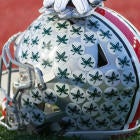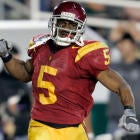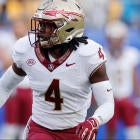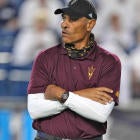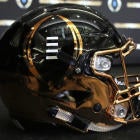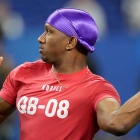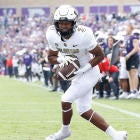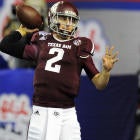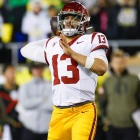Imagine Tim Tebow suing Florida or Earl Campbell taking Texas to court.
Think of face-of-the-program guys who help define not only a football team but a school.
Chris Spielman is that guy at Ohio State. Forget football for a moment, the former Buckeyes' star linebacker is one of the most respected individuals in the university's 147-year history.
That's why it pains him so much to sue the school that allowed him to become a two-time consensus All-American and Lombardi Award winner (best lineman or linebacker).
"It's a big deal. I don't want it to be," Spielman told CBS Sports of the anti-trust lawsuit against his alma mater. "I sat around and dreaded doing this because nobody wants to say, 'Former player sues Ohio State.'"
The potentially ground-breaking anti-trust complaint is seeking money from Ohio State for using the name, image and likeness of Spielman -- and 63 other former Buckeyes -- in a series of banners around Ohio Stadium.
Call it a Scarlet and Gray O'Bannon. In 2015, former UCLA basketball star Ed O'Bannon and others eventually won a class-action anti-trust suit involving enrolled players.
It left open the possibility that former players could sue for rights to their name, image and likeness. Here we go, then, with the Ohio State suit that cracks opens the door to former players taking ownership of their promotional rights after they leave.
The Ohio State banners are adorned rather conspicuously with a Honda logo. That sponsorship was supposedly sold to the auto maker by IMG, which signed a landmark $110-million deal with Ohio State in 2009.
The deal included in-stadium signage rights.
Spielman and those former Buckeyes want their cut.
"They can use my likeness to promote the university, just don't put a corporate logo on it," Spielman said. "You're talking about a guy who has represented this university for 30 years, who has helped raise $20 million for his university.
"Now I'm asking you to be a partner with me."
Ohio State hasn't responded to the suit, but don't expect capitulation on the issues anytime soon.
You can understand why the likes of IMG wouldn't want to pay. The IMG College Licensing website states it controls 80 percent of the $4.6 billion retail market for collegiate licensed merchandise. If it strikes a deal with the Ohio State players, that cuts into that 80 percent. In fact, the best legal strategy for Ohio State partners like Nike, IMG and Honda may be to fight aggressively to protect their financial turf.
You should also understand the players should have the right to protect their reputations.
"I want the basic human right to say my name and image is not going on a Planned Parenthood [sign]," one of the 64 players said. "At the OSU hospital, they might have that."
The suit suggests that day is not far off when high school prospects negotiate their post-playing rights when they sign their letter of intent. Nothing about that seemingly violates NCAA amateurism rules.
In fact, we crept closer to it last month when the first-ever negotiated contract between prospects and schools was introduced.
What makes this action so compelling is that it has the potential of alienating the generational foundation of players that have made the program great.
Two-time Heisman Trophy winner Archie Griffin issued a statement saying he is in "full support" of the lawsuit. Former Buckeye great Jim Stillwagon told the Columbus Dispatch that Ohio State "runs their operation with an iron fist." He called the school's athletic marketing arm "abusive."
This cuts to the heart of staunch defenders of the amateur model. Big Ten commissioner Jim Delany famously supported Texas A&M's right to earn money exclusively off Johnny Manziel's exploits when the quarterback was blowing up five years ago.
"If Johnny Manziel was playing arena football tomorrow," Delany told CBS Sports four years ago, "what is his uniform worth?"
You can bet that will be part of Ohio State's defense: The school's brand gave worth to those posters, not the individual player's accomplishments.
If not Spielman, Stillwagon and Griffin inhabiting those jerseys, it would be someone else. Ohio State's brand, they will say, is the constant.
Spielman said he tried to negotiate with Ohio State and IMG for eight months. The Dispatch reported the 64 players were offered a total of $230,000 -- an average of $3,953.75 per player. That's an insult from a university that can afford "fair" compensation -- the lawsuit's words -- and perhaps a tactical mistake.
The plaintiffs' lawyer, Brian Duncan, said that figure is not accurate.
"There was never a firm proposal from Ohio State or IMG," he said. "That's the best way to characterize it."
Duncan added "multiple [former] players at various high-profile programs" face the same issue.
"[The suit] should have the attention of every AD in the country," he said.
Spielman's quest gained credibility when he said any money won in the suit would be donated back to the university.
He remained upset that an Ohio State Nike throwback jersey was still attached to his name.
"I want the right to say yes or no," Spielman said. "It doesn't even matter who the sponsor is."
Being an anti-trust action, any judgment in favor of the players would be tripled. It is supposed Ohio State will fight hard to protect its position, but at what cost?
The school could alienate those beloved players as well as create a new compensation landscape for a class of former athletes.
"This is why we need a college football athlete union," said a prominent anti-trust attorney who did not to be identified. "… If you're using Chris Spielman's likeness to make money and you're not paying him, you are breaking the law."
Inside Alabama
Watch for the Aug. 29 release of "4th and Goal Every Day: Alabama's Relentless Pursuit of Perfection." The book, written by Alabama color man (and former Browns general manager) Phil Savage (along with journalist Ray Glier), contains some stunning revelations. Among them:
1. Nick Saban adopted for Alabama the Dallas Cowboys' computerized player evaluation system that started in 1963.
2. The Process is largely the offshoot of Cowboys' former talent gurus Gil Brandt and Tex Schramm.
3. Saban has completely retooled how he approaches offense and defense in the last few years. His ideal line defender has morphed from the 365-pound Terrence Cody to the 290-pound Jonathan Allen, who stopped the run as a tackle and was an elite rusher off the edge. Alabama's defenses have gotten lighter and faster. "It was Johnny Manziel who helped change us," former defensive back Geno Matias-Smith said. "We had learn how to play against guys like him."
On offense, Saban has adopted the spread with more of an emphasis on the quarterback and power running game.
4. The book also explains, even with all that, Saban has been able to recruit, coach and develop two of the most dangerous receivers currently in the NFL: Julio Jones and Amari Cooper. Sophomore Calvin Ridley is seen as the next great at that position.
5. Saban has had his share of recruiting misses. While at LSU, he refused to go after a quarterback from Findlay, Ohio. The kid had offers only from Duke and Miami (Ohio), but he turned out OK. Ever hear of Ben Roethlisberger?
6. The value of those Alabama analysts: At least nine player personnel folks on staff for the 2009, 2011, 2013 and 2015 national championships are playing "prominent roles" in NFL and Division I player development and scouting.
7. Why Jake Coker turned down a request to join the team for practice last season despite Lane Kiffin offering to send a plane. (Saban is credited with exploiting a loophole in the rules that allows former players to come back and practice with the team.)
8. How Saban schemed to get LSU star defensive back Tyrann Mathieu away from the ball in the 2012 national championship game.
9. The intricate secret behind the onside kick that turned the game in favor of Alabama against Clemson in the 2016 College Football Playoff National Championship.
10. In the spring of 2013, Alabama's No. 1 offense squared off against the No. 1 defense -- for the first time.
"4th and Goal Every Day is my textbook on Nick Saban's way of doing business at Alabama," Savage writes. Pick it up. It's worth a read.
Momentous quest by Notre Dame
If Notre Dame is going to rebound from a 4-8 season to a New Year's Six bowl, it may have to make history. The largest one-year improvement in program history was 1964. The Irish went from 2-7 in 1963 to 9-1 in Ara Parshegian's first season, a 6 ½-game improvement.
Notre Dame will have to win at least 10 to even be considered for a New Year's Six bowl in 2017. That would figure to a six-game improvement from 2016.
Some consistency would be nice. The slide from 10-3 in 2015 to 4-8 last year was the second-worst one-year drop (5 ½ games worse) in Notre Dame history. The all-time worst one-year drop came 10 years ago. The 10-3 Irish in 2006, dropped to 3-9 in 2007, a six-game difference.
Only 12 other Power Five conference teams face at least a six-game improvement to get to 10 wins. It can happen. Five FBS teams tied for the top spot last season, improving by 5 ½ games from 2015 (UCF, Troy, Georgia Tech, Army, Colorado, Eastern Michigan).












